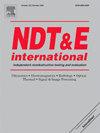Free-form surface reconstruction for adaptive imaging with 2D ultrasound arrays
IF 4.5
2区 材料科学
Q1 MATERIALS SCIENCE, CHARACTERIZATION & TESTING
引用次数: 0
Abstract
This paper introduces the Aperture Interpolation Method (AIM) for free-form surface reconstruction using 2D ultrasound arrays. Surface reconstruction plays an essential role in adaptive imaging methods, allowing for effective operation even with imprecise or unknown system geometries. The AIM method leverages the time of flight (TOF) of echos from surface reflections to estimate the surface geometry of a component under test, without requiring a pre-existing component model. In this paper we present the theoretical basis of AIM for three acquisition modes: pulse-echo, pitch-catch, and plane wave. Experimental validation is performed using a complex-shaped aluminum test piece scanned with an 11x11, 3MHz matrix array mounted on a robotic arm. The ultrasonically reconstructed surface is compared with laser scanning data for accuracy analysis. Furthermore, the ultrasonically measured surface data is used to generate Total Focusing Method (TFM) images of the component, which are then compared against micro-CT images for validation. The experimental results validate the AIM method’s capability to accurately reconstruct surfaces, facilitating reliable imaging of the components defects, thereby demonstrating its potential applicability in industrial settings.
二维超声阵列自适应成像的自由曲面重建
本文介绍了利用二维超声阵列进行自由曲面重建的孔径插值方法。表面重建在自适应成像方法中起着至关重要的作用,即使在不精确或未知的系统几何形状下也能有效地进行操作。AIM方法利用表面反射回波的飞行时间(TOF)来估计被测部件的表面几何形状,而不需要预先存在的部件模型。本文给出了三种采集模式:脉冲回波、间距捕获和平面波的AIM的理论基础。实验验证采用安装在机械臂上的11x11, 3MHz矩阵阵列扫描的复杂形状铝试件。将超声重建表面与激光扫描数据进行了精度分析。此外,超声测量的表面数据用于生成部件的全聚焦法(TFM)图像,然后将其与微ct图像进行比较以验证。实验结果验证了AIM方法精确重建表面的能力,促进了组件缺陷的可靠成像,从而证明了其在工业环境中的潜在适用性。
本文章由计算机程序翻译,如有差异,请以英文原文为准。
求助全文
约1分钟内获得全文
求助全文
来源期刊

Ndt & E International
工程技术-材料科学:表征与测试
CiteScore
7.20
自引率
9.50%
发文量
121
审稿时长
55 days
期刊介绍:
NDT&E international publishes peer-reviewed results of original research and development in all categories of the fields of nondestructive testing and evaluation including ultrasonics, electromagnetics, radiography, optical and thermal methods. In addition to traditional NDE topics, the emerging technology area of inspection of civil structures and materials is also emphasized. The journal publishes original papers on research and development of new inspection techniques and methods, as well as on novel and innovative applications of established methods. Papers on NDE sensors and their applications both for inspection and process control, as well as papers describing novel NDE systems for structural health monitoring and their performance in industrial settings are also considered. Other regular features include international news, new equipment and a calendar of forthcoming worldwide meetings. This journal is listed in Current Contents.
 求助内容:
求助内容: 应助结果提醒方式:
应助结果提醒方式:


